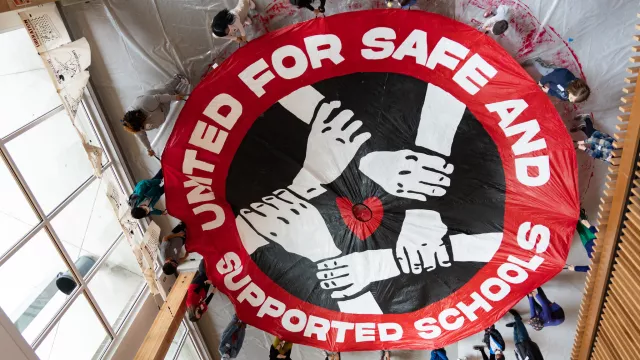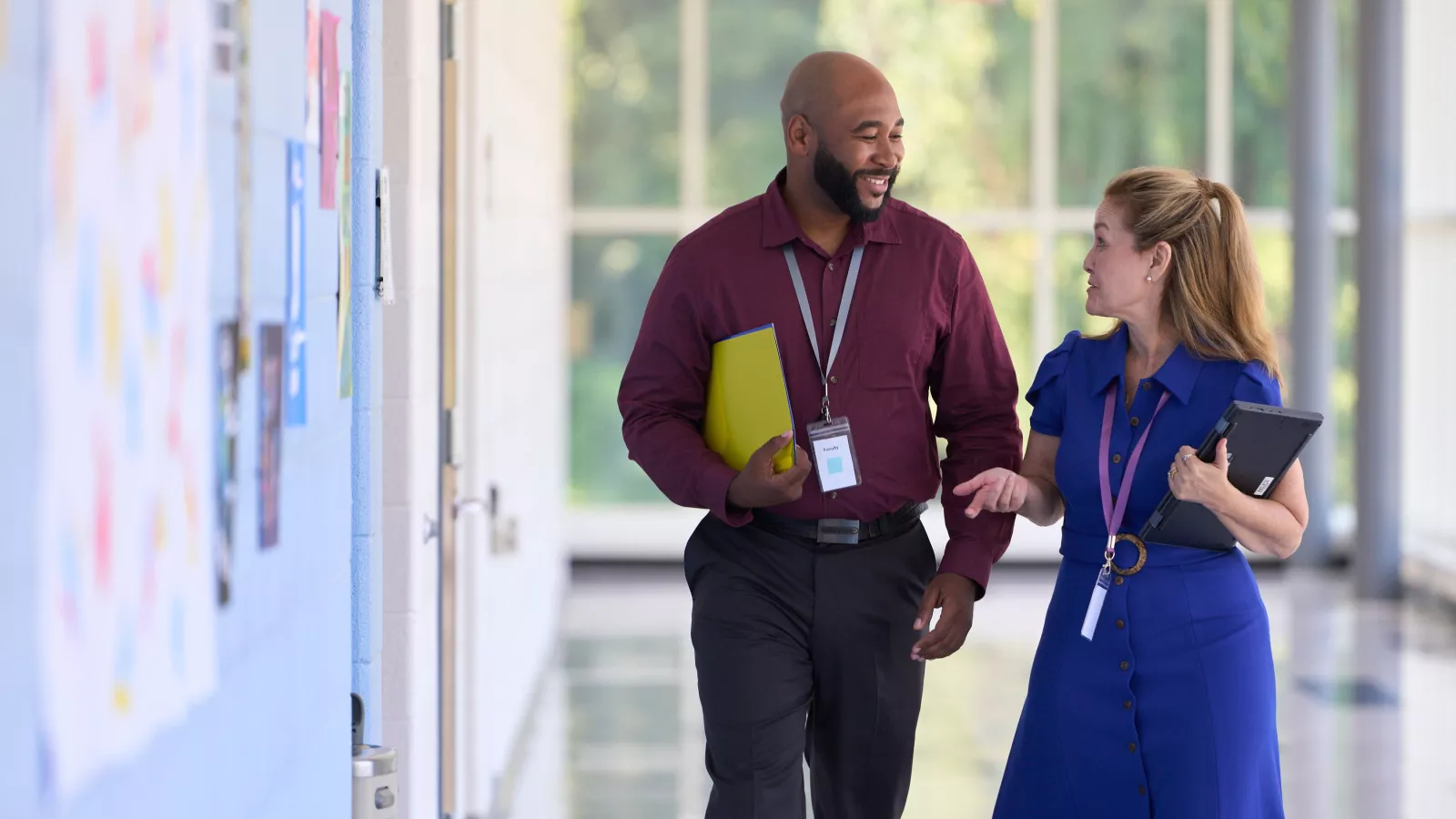Explore the Key Field Strategies
- Acquire, Use, and Manage Employee Lists
- Engage New Hires and Current Members Throughout the Year
- Make Membership and PAC Asks at Every Event
- Organize Worksite One-on-One Follow-Up
- Use Year-Round Organizing Data to Drive Decision-Making
- Strengthen Worksite Leadership Structures
- Build a Robust Communication System Within Your Union
Introduction
About the Strategies
NEA's Year-Round Organizing Framework centers around key field strategies that naturally flow through each of the four seasonal components of a typical school year. Each campaign builds on the momentum of each other, helping members and staff work together to grow our union and create the change our public schools need.
If our union members engage educators around the seven key field strategies throughout the year, we will activate more member leaders to grow our union’s membership and increase member engagement.
This guide will explore each of the field strategies and provide criteria to assess your Affiliate’s strengths and weaknesses, so that you can create the strongest organizing program possible.
Key Strategies Self-Assessment
The Local Affiliate Key Strategies Self-Assessment was designed to assist local membership organizing teams in identifying areas of strength and opportunity in their year-round organizing campaigns.
Consider using your results to assess local needs around the seven key strategies and implement plans that build a framework for a year-round organizing strategy focused on membership growth.
The Self-Assessment describes three possible levels for each component:
- Level 101 – Foundational: Understands processes and strategies for member recruitment, engagement, and retention.
- Level 201 – Mobilizing & Power-Building: Develops imaginative recruitment and retention strategies that continue to grow the union’s diverse membership and influence others to become more
actively involved in the recruitment and engagement process. - Level 301 – Agenda-Driving: Influences all members to own the agenda of the union through their active participation and attitude toward collective action.
Note: It is likely states will have a range of ratings, depending on particular strengths and challenges. The rubric offers specific, tactical insight on how to move from one level to the next.
Surround Sound and the 7 Key Strategies
While assessing your progress on the key strategies, consider how you can leverage simultaneous, multi-channel communications tools to create a “surround sound” effect to amplify your message and layer over your field program.
A good Surround Sound strategy reaches your potential members through multiple channels, raising their awareness of the Association and moving them closer to joining.
Want a sample six-week Surround Sound plan using Email, SMS, Hustle, Telephonic Organizing, and Member Organizers?
Key Strategy 1: Acquire Employee Lists
Key Strategy 1: Acquire, Use, and Manage Employee Lists
Better list acquisition practices allows affiliates to assess their member density and target organizing resources. Improve the processes and policies related to acquiring employee lists, using lists, and managing lists effectively.
Need Data Support?
Building strong lists allows organizers to more effectively and efficiently reach educators and protect public schools. Don't let the process of gathering data intimidate you! We've broken down the basics for you in our guide to building strong organizing lists. If you need further support, contact contact NEA at [email protected].
Strategy 1 Self-Assessment
- Potential member lists include only information to be able to contact potential members at work.
- Inconsistent about asking for potential member lists.
- Inconsistent statewide procedures for requesting, securing, cleaning, and processing lists into a state-designated database (i.e., NEA360 or VAN).
- State Membership Processors, UniServ staff, and/or leaders have limited knowledge of how to use and/or manage employee lists once obtained in the state-designated database.
- Asks for/receives lists for some or most locals (i.e., only targeted or large locals).
- List acquisition is past practice, but not formalized as part of contract language and/or school board policy.
- Active efforts to win state legislation, contract language, and/or school board policy to acquire lists.
- State procedure for requesting lists at the local level is in place.
- List is accessible to union/union leadership only and may not be in a format that is user-friendly.
- State uses surround sound tactics (social media, telephonic organizing, email, and SMS/Hustle) to clean and improve lists.
- State Membership Processors, UniServ staff, and/or leaders understand how to use and/or manage employee lists once they are in the state-designated database.
- Leaders and/or UniServ staff use lists during back-to-school recruitment period to make a membership/activism ask.
- State adopts a standard business practice for requesting, securing, cleaning, and processing lists into a state-designated database (i.e., NEA360 or VAN) and this is done at least twice per year.
- State receives employee lists for all locals as new employees are hired at least once per quarter.
- List acquisition is part of contract language, state legislation, and/or school board policy.
- State affiliate works to identify Aspiring Educator graduates (student members) and their first job.
- Procedure for requesting, securing, cleaning, and processing lists into a state-designated database (i.e., NEA360 or VAN) is in place and completed at least once per quarter.
- State affiliate has a designated primary contact responsible for implementing the business practices associated with list acquisition, use, and management.
- Lists are accessible, in a user-friendly format, so that Building Reps, membership chairs, Member Organizers, UniServ staff, etc. can use them to organize.
- All local unions designate a primary contact to work with the state affiliate to implement the business practices with list acquisition, use, and management.
- State uses surround sound tactics (social media, telephonic organizing, email, and SMS/Hustle) to clean and improve lists at least twice per year.
Key Strategy 2: Engage All New Hires Throughout the Year
Key Strategy 2: Engage All New Hires and Current Members Throughout the Year
Engage with new hires, potential members, and current members year-round. A plan for continuous year-round outreach allows local leaders, Building and/or Union Reps, and Member Organizers to initiate one-on-one conversations that establish the union as a trusted resource.
Organize Worksite Visits
Worksite visits are great ways to have one-on-one organizing conversations with as many members and potential members as possible. Use this guide to make the most of your time, whether you are making a solo visit or hosting a worksite blitz.
New Hire Orientations
New educators never forget the friendly face on orientation day who made them feel welcomed. Make the most of this chance at a great first impression! This guide offers step-by-step planning and some research-based best practices for putting together, a successful orientation that sets the stage for growing and strengthening the union.
Key Strategy 2: Self-Assessment
- First contact with new hires by union occurs at or after New Employee Orientation (NEO).
- State affiliate has not yet prioritized resources for pre-orientation engagement activities.
- Limited engagement or outreach by President or Early Career Educators (ECEs) prior to orientation.
- Some Building and/or Union Reps are trained to hold organizing conversations and involved in reaching out to new hires.
- Some outreach to new hires occurs prior to orientation, but it is not systematic or sustained.
- Limited resources are available from the state affiliate, but not utilized by the targeted locals for pre-orientation or YRO engagement.
- First contact with new hires by union occurs at New Employee Orientation and New Hires are asked to complete YRO Surveys for targeted locals.
- State affiliate has a robust plan to support ECEs and local leaders in engaging new hires through multiple contacts between the date of hire, orientation, and year-round.
- All Building and/or Union Reps receive standardized training on the 1:1 curriculum and new hire recruitment before the start of the school year, from or supported by the state affiliate.
- State affiliates intentionally work with locals to engage Aspiring Educators (student members) and other graduating seniors at schools of education.
- All engagement events and 1:1s include a membership ask and tracking (YRO survey data) of the contact in NEA360/VAN.
- State affiliate has dedicated resources for targeted locals to execute pre-orientation engagements.
Key Strategy 3: Make a Membership Ask at Every Event
Key Strategy 3: Make a Membership and PAC Ask at Every New Employee Orientation and Union-Led Event
Create a statewide YRO plan to make a membership and PAC ask at every union-led event. Make a game plan that helps local unions approach, recruit, and follow up with potential members.
Recruitment Guide
Our Recruitment Guide shares tips and tools for making membership asks online and at events. Find videos, graphics, and downloadable posters to help you spread the word about your membership drive.
Key Strategy 3: Self-Assessment
- Union is inconsistent in making membership asks of all new hires.
- Attendance at NEOs is mostly limited to staff and governance leaders.
- State affiliate sporadically tracks NEOs statewide for coverage and participation at the start of the year, and does not track throughout the year.
- ECEs attend and help recruit members at some NEOs.
- Union has a presence at NEOs, but no time on the district agenda, or is only the recognized sponsor for a meal.
- State affiliate has a system to track and cover NEOs in targeted locals only.
- Training is provided to individuals attending NEOs.
- PAC asks are inconsistent at union-led events and not all membership forms contain a PAC contribution ask.
- Most union-led events include a membership ask and a PAC ask.
- State affiliate supports NEOs at the beginning of the school year and sporadically throughout the year.
- ECEs attend and help recruit members at some NEOs.
- Union member benefits partners participate in some NEOs at the start of the school year.
- Union has a presence at NEOs, but no time on the district agenda.
- State affiliate has a system to track and cover NEOs in targeted locals only.
- Some training is provided to ECEs, Building Reps, and local leaders who volunteer for NEOs and YRO, with no systematic plan for follow-up at the worksite.
- PAC contribution information is on the membership form.
- YRO survey data is used sporadically for follow-up with members interested in political action.
- State focuses on PAC contributions as part of their Representative Assembly, but not throughout the year.
- Every union-led event includes a membership PAC ask.
- State affiliate supports all NEOs scheduled throughout the year (including Higher Ed, ESP, and urban districts).
- ECEs are a part of planning and delivering aspirational NEOs that are budgeted, adequately resourced, scheduled, and publicized by their state and local affiliates.
- Community organizations partner with the state and local affiliates on events to offer support to new hires.
- In the absence of a district-run orientation, the union holds their own NEO for all new hires.
- Trained ECEs, Building Reps, Member Organizers, and leaders work the NEO event and make membership asks following 1:1s with participants.
- State affiliate or locals have a system in place to assess NEO results and reconcile data to determine new members, identify potential members from YRO survey data, and new hires who have not been engaged yet.
- Active PAC committee uses YRO survey data to build rank-and-file engagement.
- State affiliate recognizes locals with the most recurring contributions to PAC by the highest number of members.
Key Strategy 4: Organize Follow-Up One-on-One Conversations
Key Strategy 4: Organize Follow-Up One-on-One Conversations
Focus on in-person follow-up conversations. Members are the most effective recruiters of new members.
A strong follow-up plan supports Building and/or Union Reps, Member Organizers, and worksite activists in having targeted one-on-one (1:1) organizing conversations with new and potential members at the worksite focused on issues and built on relationships, trust, and experience.
Have Transformative Conversations
When members speak about how their local makes a difference in their own work, community, and personal lives, they are an influential force in building power in the union. This guide will help you start recruitment conversations and navigate those questions while highlighting all that NEA has to offer at the local, state and national level.
Key Strategy 4: Self-Assessment
- Follow-up conversations with new hires and potential members occur but are not tracked by the state and/or local affiliate.
- Inconsistent collaboration between state and local affiliates for organizing conversation training for NEO follow-up 1:1s.
- State affiliate’s assessment of Building and/or Union Rep density is minimal or incomplete and not updated regularly in NEA360 or other database.
- Building and/or Union Rep structure at the local level is inconsistently supported by the local and state affiliate.
- State affiliate supports some training of Building and/or Union Reps and Member Organizers for follow-up conversations with new hires and
potential members that includes the organizing conversation model, mapping, and data management. - State and local affiliate tracks some follow-up conversation data.
- Local affiliates have an adequate member-to-Building and/or Union Rep ratio (i.e., 10:1) that is reported and tracked by the state affiliate in NEA360 or other database.
- State affiliate supports some specifically targeted locals in using the YRO survey data to have strategic conversations with all potential members and new hires.
- State affiliate has a YRO survey data process that includes frequent uploads of conversations, but it is not always smooth or followed with fidelity.
- State affiliate frequently uses Member Organizers to follow up with potential members who did not join during initial contact with the union.
- State affiliate supports training of members in various roles for follow-up with all members and potential members at each worksite. Training includes: listening, asking probing questions, getting a commitment, leader ID, making the membership ask, etc.
- State affiliate provides a consistent level of support, resources, and curriculum for Building and/or Union Rep and Member Organizer trainings.
- State affiliate supports all local unions in using YRO survey data to hold follow-up conversations with new hires and potential members (i.e., Member Organizers are regularly used for follow-up).
- Data is returned regularly from the state level to the local level and entered in VAN/NEA360.
- State affiliate supports all local unions in prioritizing natural leader identification in worksites without Building and/or Union Reps.
Key Strategy 5: Use Data to Plan Follow-Up Engagements
Key Strategy 5: Use YRO Data to Drive Decision-Making, Plan Campaigns, and Offer Engagement Opportunities
The YRO Campaign survey data identifies opportunities to develop activists, organizing campaigns,
issue-specific education, and professional supports that can be used to execute meaningful engagements that help win campaigns.
Year-Round Organizing Cards
Year-Round Organizing cards are important tools for gathering the information about educators who are interested in learning about or getting more involved in the union. The data from this form is then shared with organizers to ensure they are followed up with!
Key Strategy 5: Self-Assessment
- YRO survey data is inconsistently collected and reviewed for top-line take-aways only.
- YRO survey data is not used for individualized conversations to drive turnout to engagement events.
- Building/Union Reps and/or Member Organizers are not aware of or encouraged to use YRO survey cards as part of their 1:1 follow-up conversations.
- Participants at engagement events sign in, but the information is not regularly tracked in a statewide database (i.e., VAN/NEA360).
- Minimal collaboration exists between state and local affiliates to share YRO survey data, plan engagements, or drive turnout for planned engagements.
- YRO data is used to plan PD events, but there is no aspirational membership ask with minimal follow-up.
- State affiliate tracks some engagement events in a statewide database
(i.e., VAN/NEA360). - Participants at some of the engagement events are tracked in a statewide database (i.e., VAN/NEA360).
- YRO survey data is reviewed once a year to identify emerging leaders and new members for activist roles in campaigns.
- YRO survey data is used sporadically for individualized conversations and occasionally used to drive turnout to engagement events.
- YRO survey data is used to plan relevant PD with a membership ask.
- State affiliate tracks all engagement events and participants in a statewide database (i.e., VAN/NEA360).
- YRO data is routinely used to develop emerging leaders and co-create member-led issue campaigns.
- YRO data is continually reviewed at all levels for individualized conversations and to drive turnout to engagement events.
- YRO survey data is used to inform decisions around planned programming and developing issue campaigns.
- YRO data is used to plan relevant PD that encompasses an aspirational membership ask with routine and robust follow-up.
Key Strategy 6: Strengthen Worksite Leadership Structures
Key Strategy 6: Strengthen Leadership Structures at Every Worksite
A diverse group of natural leaders exists in all workplaces. It is essential to identify them, train and support them, and offer them pathways to use their skills to move others to action.
Leadership Development at NEA
We prepare educators to lead at home and with us. NEA's leadership resources help members build the knowledge and skills they need to be an effective leader at the local, state, and national stage.
Key Strategy 6: Self-Assessment
- Some locals have an identified leadership team and executive board.
- Statewide practice for tracking leadership roles in the NEA data ecosystem is inconsistent.
- There is a statewide system of committees that represent the affiliate’s diversity.
- Local leaders are inconsistent about sharing information with their members.
- Identification of new leaders/activists is inconsistent, with no formal assessment of activists.
- A clear pathway to further engagement and leadership roles in the union is not articulated to most members.
- A membership committee exists in some locals and at the state affiliate level.
- Most locals have an identified leadership team and executive board.
- Statewide practice for tracking leadership roles in the NEA data system
is consistent. - There is a statewide system of committees that represent the affiliate’s
diversity, and committees meet regularly. - Local leaders share information with their members when asked by state leadership.
- Worksite leadership roles are undefined or sometimes vacant in a majority of locals and are not tracked in the NEA data ecosystem.
- Some new leaders and activists are assessed using a behavioral scale with occasional asks.
- Lead Member Organizers coach other members in organizing with staff support.
- A membership committee exists in most locals and at the state affiliate level.
- All locals have an active, identified leadership team and executive board that reflects the affiliate’s membership diversity.
- Leadership roles are tracked in the NEA data ecosystem and updated as part of a yearly business operational process.
- There is a system to identify new leaders and activists that uses an assessment system tracked in VAN/NEA360.
- Member engagement and recruitment is led by members with staff support.
- Membership committees, contract action teams, bargaining teams, and other committees of members exist to lead the union’s strategic priorities.
Key Strategy 7: Build a Robust Communication System
Key Strategy 7: Build a Robust Communication System Within Your Union
Communication structures facilitate two-way communication between rank-and-file members and leadership that purposefully emphasizes transparency and democratizes decision-making.
"Let's Talk About" Conversation Starters
Looking for a way to start an organizing conversation with potential members? We’ve created communication tools and explainers about student debt, pensions, health care, and unions that you can use to introduce the benefits of membership.
Key Strategy 7: Self-Assessment
- The state affiliate data management system has a home email and phone number for at least 75% of all members.
- A consistent email program reaches members, but not potential
members. - The state affiliate website is updated regularly and offers contact information, links to locals, and an easy-to-find join link. Some locals have a website and/or Facebook page with an easy-to-find join link.
- State affiliate has carefully chosen which social media channels to use and keeps them regularly updated.
- The state affiliate collects YRO cards and uses the information to subscribe potential members for an NEA email journey.
- The state affiliate communicates statewide success stories and wins to members and potential members.
- The state affiliate offers communications training to local presidents and leaders.
- The state affiliate data management system has a home email for at least 80% of all members and collects potential member home emails and phone numbers. This contact information is updated at least once a year.
- The state affiliate and the majority of locals have a website that is updated several times a year and has an easy-to-find join link.
- Emails to members have follow-up asks and provide opportunities for two-way communication and member feedback on the content.
- The state affiliate collects YRO cards and uses the information to target potential members with specific asks or information based on the responses.
- Surround Sound tactics are used intentionally during each phase of the YRO campaign.
- The state affiliate uses YRO cards to build hotlists for statewide use.
- The state affiliate uses hotlists to target engagement opportunities to
members and for recruitment of new members. - The state affiliate collects and communicates state and local success
stories and wins. - The state affiliate cross-posts on various social media platforms.
- The state affiliate data management system has a home email and phone number for at least 90% of all members and collects home and email for potential members. This contact information is updated twice a year.
- Emails to members and potential members communicate wins, make follow-up asks, and provide opportunities for two-way communication with the union.
- The state affiliate collects YRO cards and uses the information to target potential members with specific asks or information based on the responses.
- Surround Sound tactics are used intentionally during each phase of the YRO campaign.
- The state affiliate uses YRO cards and builds and uses hotlists to target engagement opportunities to members and for recruitment of new members.
- The state affiliate cross-posts on their social media platforms, inviting member and potential member interaction.
- The state affiliate and the majority of locals have websites and/or a Facebook page that is updated frequently and has easy-to-find join links.
- A majority of locals have a social media presence besides Facebook and use it to share local information and amplify state and national posts.
- The state affiliate supports locals in creating a plan for two-way communication between members, the state affiliate, and the local union.
- The state affiliate shows responsiveness to member interests and needs by developing programming from YRO cards and other sources of input.
More Organizing Resources
MORE ORGANIZING TOOLS AND RESOURCES

Conversation Guides

Year-Round Organizing Framework

NEA's Guides to Organizing
Use Your Educator Voice.

